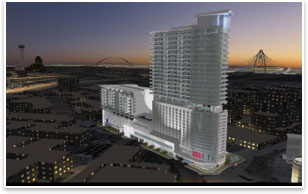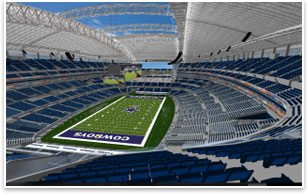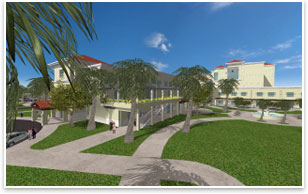Real Solutions for Virtual Reality
by Sara Fernández-Cendón
 Summary: HKS Inc.’s visualization studio has built a powerful real-time rendering engine based on gaming software. But the technology is more than many architecture firms can handle, and, in most cases, it might be more than they actually need. Summary: HKS Inc.’s visualization studio has built a powerful real-time rendering engine based on gaming software. But the technology is more than many architecture firms can handle, and, in most cases, it might be more than they actually need.
A powerful tool, but even more powerful
HKS Inc. made headlines in 2007 when it announced its decision to license the Unreal Engine 3, by Epic Games Inc., a company based in Cary, N.C. The product, which is not commonly used in architectural visualization, is the software behind video games such as BioShock and Unreal Tournament 3.
Pat Carmichael, manager of advanced technologies with HKS, and senior programmer Chris Roberts had been working with the technology for more than a decade. But HKS’s decision to license the Unreal Engine, including its source code, gave Carmichael and his team the ability to interact more closely with the virtual reality software and build it up to meet the demands of the firm’s huge projects.
The result of HKS’s work with the software is ARCHengine, a supercharged version of the Unreal Engine that can handle real-time renderings of stadium-sized projects with remarkable ease.
To get a sense of the power behind ARCHengine, consider that typical gaming software pushes about 1–2 million actual polygons to create an animation. ARCHengine pushes approximately 30 million. You might’ve heard that it took months to render the 2008 animated film Wall-E, produced by Pixar Animation Studios; Carmichael says ARCHengine has the capacity to render the entire film in one day.
HKS has used ARCHengine on approximately 150 projects, including the Dallas Cowboys new stadium opening in June 2009 and several other stadiums. Carmichael says the size and complexity of stadiums makes them ideal for interactive 3D renderings.
In the case of the Dallas Cowboys project, owner Jerry Jones was able to inspect the structure from every angle in real time. He could have tried out each of the stadium’s 89,000 seats had he wanted to. Sponsors, too, were able to monitor progress and see what kind of presence they would have in the finished structure.
Even Dallas Cowboys fans wishing to buy a seat license are now able to go to the team’s Web site and get 180-degree panoramas simply by clicking on each section of the new stadium.
Wondering how long it took Carmichael to develop the 1,600 views needed for this feature? When asked, he says the average visualization company would’ve taken three months. It took him only three days.
 Architects, not game designers Architects, not game designers
Despite impressive statistics, gaming software is still nowhere near becoming the standard in architectural visualization. Jay Wilbur, vice president of business development at Epic, says that although several firms are evaluating the technology, HKS remains his company’s sole architectural client.
This comes as no surprise to manufacturers of traditional rendering software applications. In addition to covering high licensing costs, HKS has devoted years to developing the technology to fit the needs of specific projects.
“HKS is using technology from the gaming industry not intended for architectural uses,” says Chris Ruffo, senior industry manager for design visualization at Autodesk Inc. Autodesk is the leading 2D and 3D design software company behind such industry staples as AutoCAD, Revit Architecture, and 3ds Max. “They’re pioneers, and they’ve been looking into this technology for a very long time.”
Compared to gaming engines and similar off-the-shelf virtual reality applications such as Quest 3D, produced by Netherlands-based Act-3D, Autodesk’s products offer limited real-time animation capabilities. But Autodesk’s advantage lies in the seamless integration of its various modeling and rendering applications.
“With gaming engines, you have to publish out data from the design environment,” says Doug Eberhard, senior director and industry evangelist at Autodesk. “One of the benefits we offer is a seamless workflow with real-time visualization built into the design and creation process. Having a gaming-style interface coupled with the design environment is a better way to design ‘real projects’ than the traditional way of modeling and publishing out in order to get the visualization and real-time experience.”
Jeff Mottle, founder of CGarchitect.com, a site devoted to architectural visualization, says the vast majority of studios only use still images because animation is an expensive process. He estimates the cost to be between $5,000 and $10,000 on the low end, up to about $200,000, depending on the scale of the project. Real-time rendering adds another layer of programming to the process, which results in even higher costs.
Besides HKS, Mottle knows of a few firms that have experimented with free versions of gaming engines, but as far as he knows, none of this experimentation has passed the research and development mode yet. He estimates the fraction of firms using virtual reality software at about 3 percent, with firms using gaming engines being just a fraction of a percent.
And in any case, in Mottle’s opinion, real-time animation is not always necessary. Exceptionally complex projects aside, designs can often be communicated effectively through still images or simple animations. This is where Autodesk applications and similar products shine. Gaming engines provide the best quality of animation for virtual reality, but they don’t provide the same amount of detail as still images, or the same quality of animation as products such as 3ds Max, and they’re certainly more difficult to master.
Carmichael recognizes that the visual acuity in ARCHengine is not quite as good as what still renderings can achieve, although he expects to achieve photorealistic images in real time by the end of this year. Still, he emphasizes that the advantage of the workflow he has developed around ARCHengine lies in its ability to bring designers, clients, consultants, and contractors together to interact with massive projects through first-person discovery.
“Now we’re able to focus not only on the aesthetics of the building, but also on its function,” he says.
 Unreal and other real options Unreal and other real options
HKS, which currently has $20 billion under construction, is the kind of firm that can afford a solution like the Unreal Engine. Although according to Epic’s Jay Wilbur the software company now offers a per-seat model to accommodate architects, he still admits the technology, while well worth it, is not inexpensive.
Off-the-shelf products such as Quest 3D, which costs about $1,600 (close to $13,000 for a fuller version of the program), are a more affordable solution for smaller firms interested in developing virtual interactive walkthroughs.
Take, for instance, a project developed by Michiel Quist, owner of 3idee, a Dutch company specializing in architectural visual media. Quist was able to create an interactive model of the entire city of Utrecht, where his business is based, using Quest 3D. He chose the product because it involved no hidden licensing costs and it offered flexibility in terms of programming. Although the learning curve was significant, products like Quest 3D are usually well documented.
For more complex projects, there’s always HKS. The firm has just started working with external clients to produce ARCHengine renderings (either films or interactive environments), but the cost of this service starts at about $30,000.
Also Autodesk, which currently offers real-time feedback only in the viewport, is now working on a real-time engine named “Newport.” The new software is being designed as a visualization and presentation tool.
Sean Young, Newport product manager, describes Newport as being to Revit Architecture what Microsoft PowerPoint is to Word or Excel. Although the company doesn’t have firm plans for its release yet, the new software promises ease of use for architects who are experts not in visualization, but in design.
|



